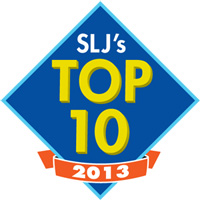
Flexibility and personalized education: That’s what the learners of 2014 will expect from their libraries. We must be available everywhere, nimbly respond to students’ needs, and allow kids to learn in ways that suit them.
The way I see it, it’s our responsibility to use the physical and virtual spaces we call library to meaningfully connect the world of school with the learning possibilities presented by emerging tools, resources, platforms, and activities. From BYOD to potent curation tools, 2014 offers increasingly significant opportunities to inspire and augment creative, connected, and personalized learning.
These opportunities include considering the role the library might play in a growing focus on STEAM (STEM + art) learning and coding, in harnessing the power of games to motivate learners, and in celebrating emerging transmedia formats for the book.
Free, augmented reality applications like Aurasma offer exciting potential for interactive facilities and websites. Google Drive, Apps, and Hangouts turn collaboration and real-time connection into classroom (and library) norms.
Speaking of connection, as a teacher librarian, you have to work hard to be isolated. Our monthly TL Virtual Café, the new TL News Night! and #TLChat, live and archived, solidify our tribe as an online community of practice.
It’s an exciting time. Here are the top trends for 2013 and beyond.
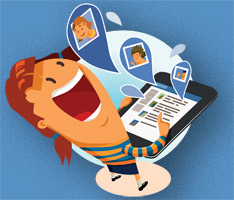 One-to-one and BYOD. As more and more schools deploy tablets and Chromebooks, librarians are being tapped to manage and distribute devices, implement instruction and professional development, and thoughtfully select apps for learning and creating. But let’s be realistic about how kids interact with personal devices. While districts launch million-dollar rollouts, librarians should help educators avoid situations like the recent initiative in Los Angeles, where students hacked school-issued iPads for their personal use.
One-to-one and BYOD. As more and more schools deploy tablets and Chromebooks, librarians are being tapped to manage and distribute devices, implement instruction and professional development, and thoughtfully select apps for learning and creating. But let’s be realistic about how kids interact with personal devices. While districts launch million-dollar rollouts, librarians should help educators avoid situations like the recent initiative in Los Angeles, where students hacked school-issued iPads for their personal use.
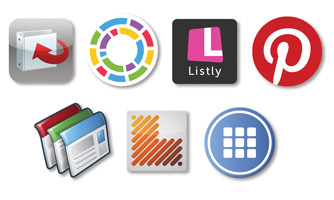 Collection rethink. Increasingly, collection is less what you buy and more what you use and make discoverable. Do you prefer LibGuides, LiveBinders, Symbaloo, Google Sites, or your OPAC (online public access catalog) for hosting curated collections? I favor LibGuides for ensuring access to instruction, databases, OER (open educational resources), and archives of student work. Others use Symbaloo and Pinterest, a go-to rabbit hole for professional inspiration. A newish subgenre of curation tools—the learning playlist—enables a media-rich take on the traditional reading list. Check out MentorMob, blendspace, Learni.st, Listly, and Tildee. The Web2MARC tool, created by Digital Libraries to School Libraries, makes it easy to leverage expensive library software and give students access to free digital content on our OPACs.
Collection rethink. Increasingly, collection is less what you buy and more what you use and make discoverable. Do you prefer LibGuides, LiveBinders, Symbaloo, Google Sites, or your OPAC (online public access catalog) for hosting curated collections? I favor LibGuides for ensuring access to instruction, databases, OER (open educational resources), and archives of student work. Others use Symbaloo and Pinterest, a go-to rabbit hole for professional inspiration. A newish subgenre of curation tools—the learning playlist—enables a media-rich take on the traditional reading list. Check out MentorMob, blendspace, Learni.st, Listly, and Tildee. The Web2MARC tool, created by Digital Libraries to School Libraries, makes it easy to leverage expensive library software and give students access to free digital content on our OPACs.
 MOOCs. When I wrote about MOOCs (massive open online courses) back in 2012, we were just beginning to see their potential for K–12. While the education community debated their effectiveness, the Gates Foundation, this year, announced its MOOC Research Initiative (MRI). Overall, MOOCs have taken hold as a serious professional development strategy. Whether you take them for credit or scan them casually, online courses are widely available for librarians and educators. Check out R. David Lankes’s New Librarianship MOOC or SJSU’s Hyperlinked Library MOOC.
MOOCs. When I wrote about MOOCs (massive open online courses) back in 2012, we were just beginning to see their potential for K–12. While the education community debated their effectiveness, the Gates Foundation, this year, announced its MOOC Research Initiative (MRI). Overall, MOOCs have taken hold as a serious professional development strategy. Whether you take them for credit or scan them casually, online courses are widely available for librarians and educators. Check out R. David Lankes’s New Librarianship MOOC or SJSU’s Hyperlinked Library MOOC.
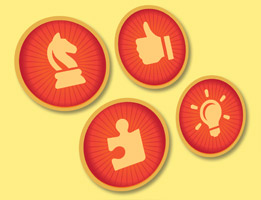 Badges for independent learning. Though some claim they go against interest-driven learning, digital badges became more prevalent. Supported by the MacArthur Foundation, Mozilla’s Open Badges presents a free standard for creating, issuing, and verifying badges as indicators of accomplishment or attaining a skill. In 2013, badges documented evidence of professional learning as well. The National Science Teachers Association, the Smithsonian Institution, and the Khan Academy offer digital badges for educators and students. In October, Connected Educators Month organizers provided a variety of badges to encourage and reward participation.
Badges for independent learning. Though some claim they go against interest-driven learning, digital badges became more prevalent. Supported by the MacArthur Foundation, Mozilla’s Open Badges presents a free standard for creating, issuing, and verifying badges as indicators of accomplishment or attaining a skill. In 2013, badges documented evidence of professional learning as well. The National Science Teachers Association, the Smithsonian Institution, and the Khan Academy offer digital badges for educators and students. In October, Connected Educators Month organizers provided a variety of badges to encourage and reward participation.
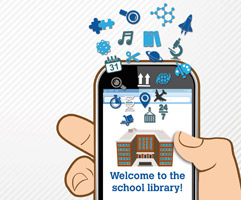 Mobilizing the library. “Smartphone adoption among American teens has increased substantially,” and one in four teens are “cell-mostly” Internet users, according to a 2013 Pew Internet & American Life Project report. There’s no reason for you (or your kiddos) not to build a mobile app or site offering anytime/anyplace library instruction and resources. At the very least, show your learners free mobile apps, such as Gale’s Access My Library or the one-password MackinVia app.
Mobilizing the library. “Smartphone adoption among American teens has increased substantially,” and one in four teens are “cell-mostly” Internet users, according to a 2013 Pew Internet & American Life Project report. There’s no reason for you (or your kiddos) not to build a mobile app or site offering anytime/anyplace library instruction and resources. At the very least, show your learners free mobile apps, such as Gale’s Access My Library or the one-password MackinVia app.
 Flipping strategies. Through our curation efforts, librarians have become master flippers. Mobile sites and apps expand the learning resources available from home. Flipping-friendly platforms such as Schoology, Sophia, Edmodo, and Canvas for K–12 offer engaging features like badges and analytics. Tools like Mozilla’s Popcorn Maker turn video into interactive, hyperlinked conversations. Flipgrid looks like a game changer for blended video discussion and reflection. Classroom teachers learn from us as we coach them in screencasting, curation, and playlist tools.
Flipping strategies. Through our curation efforts, librarians have become master flippers. Mobile sites and apps expand the learning resources available from home. Flipping-friendly platforms such as Schoology, Sophia, Edmodo, and Canvas for K–12 offer engaging features like badges and analytics. Tools like Mozilla’s Popcorn Maker turn video into interactive, hyperlinked conversations. Flipgrid looks like a game changer for blended video discussion and reflection. Classroom teachers learn from us as we coach them in screencasting, curation, and playlist tools.
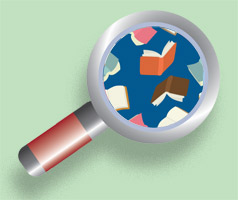 Discovery services. This year, I introduced EBSCO’s Discovery Service, a Google-like search, at our high school. The goal was to allow students to quickly access our full collection across its multiple silos and brands, maximizing use of all digital content—ebooks, journal articles, media, and more. I wanted our students to see the big picture. Search results are huge, underscoring the need for students to cleverly use filters and descriptors to execute an artfully constructed query.
Discovery services. This year, I introduced EBSCO’s Discovery Service, a Google-like search, at our high school. The goal was to allow students to quickly access our full collection across its multiple silos and brands, maximizing use of all digital content—ebooks, journal articles, media, and more. I wanted our students to see the big picture. Search results are huge, underscoring the need for students to cleverly use filters and descriptors to execute an artfully constructed query.
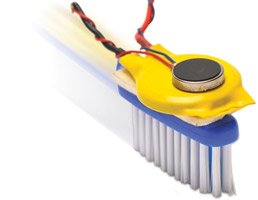 Flexible learning environments and maker spaces. You don’t need a 3-D printer to host a maker space. A small area can suffice, along with some portable, tech-friendly furniture, with charging stations and syncing ports. These things encourage easy space reconfiguration for collaborating, creating, performing, and project-based learning. Interest-driven maker spaces in libraries support activities such as sewing, gardening, crafts; STEAM-oriented activities like coding with Scratch; and engaging in electronics and robotics with Arduino, Squishy Circuits, Brushbots, and MaKey MaKey. Check out Make Magazine for inspiration relating to invention and personalized learning.
Flexible learning environments and maker spaces. You don’t need a 3-D printer to host a maker space. A small area can suffice, along with some portable, tech-friendly furniture, with charging stations and syncing ports. These things encourage easy space reconfiguration for collaborating, creating, performing, and project-based learning. Interest-driven maker spaces in libraries support activities such as sewing, gardening, crafts; STEAM-oriented activities like coding with Scratch; and engaging in electronics and robotics with Arduino, Squishy Circuits, Brushbots, and MaKey MaKey. Check out Make Magazine for inspiration relating to invention and personalized learning.
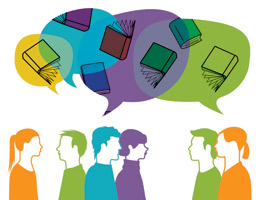 Social reading. Authors converse via hashtags. Librarians run virtual book clubs. People of all ages discuss books on myriad platforms. Subtext, a free app, lets reader groups exchange ideas. GoodReads and LibraryThing convene individuals, book clubs, and classes. My students use GoodReads and the YALSA Teen Book Finder app as readers’ advisory tools. Our OPACs enable the creation of lists, friending, commenting, recommending, bookmarking, and annotating ebooks. The new, COPPA-compliant BiblioNasium offers the under-13 set a place to create virtual shelves and wish lists; share reviews, ratings, and recommendations; and earn badges.
Social reading. Authors converse via hashtags. Librarians run virtual book clubs. People of all ages discuss books on myriad platforms. Subtext, a free app, lets reader groups exchange ideas. GoodReads and LibraryThing convene individuals, book clubs, and classes. My students use GoodReads and the YALSA Teen Book Finder app as readers’ advisory tools. Our OPACs enable the creation of lists, friending, commenting, recommending, bookmarking, and annotating ebooks. The new, COPPA-compliant BiblioNasium offers the under-13 set a place to create virtual shelves and wish lists; share reviews, ratings, and recommendations; and earn badges.
 Inequity. I am profoundly aware and deeply saddened that I write about trends that affect a certain privileged segment of young people. Increasingly, children will grow up without school library programs, without the influence of a teacher librarian who will introduce them to these resources and how to thoughtfully leverage the emerging information and communication tools of their own time for success as citizens and full participants. Will we make 2014 the year we wake up our communities to this growing divide?
Inequity. I am profoundly aware and deeply saddened that I write about trends that affect a certain privileged segment of young people. Increasingly, children will grow up without school library programs, without the influence of a teacher librarian who will introduce them to these resources and how to thoughtfully leverage the emerging information and communication tools of their own time for success as citizens and full participants. Will we make 2014 the year we wake up our communities to this growing divide?
Joyce Kasman Valenza (@joycevalenza) is the teacher-librarian at Springfield Township (PA) High School and a blogger at SLJ’s “NeverEnding Search.”


